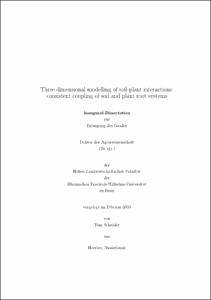Schröder, Tom: Three dimensional modelling of soil-plant interactions: consistent coupling of soil and plant root systems. - Bonn, 2009. - Dissertation, Rheinische Friedrich-Wilhelms-Universität Bonn.
Online-Ausgabe in bonndoc: https://nbn-resolving.org/urn:nbn:de:hbz:5N-18008
Online-Ausgabe in bonndoc: https://nbn-resolving.org/urn:nbn:de:hbz:5N-18008
@phdthesis{handle:20.500.11811/3950,
urn: https://nbn-resolving.org/urn:nbn:de:hbz:5N-18008,
author = {{Tom Schröder}},
title = {Three dimensional modelling of soil-plant interactions: consistent coupling of soil and plant root systems},
school = {Rheinische Friedrich-Wilhelms-Universität Bonn},
year = 2009,
month = jul,
volume = 1,
note = {To understand how the uptake of water by roots locally affects and is affected by the soil water distribution, 3D soil-root water transfer models are needed. Nowadays, fully coupled 3D models at the plant scale, that simulate water flow along water potential gradients in the soil-root continuum, are available. However, the coupling of the soil and root system is not investigated thoroughly. In the available models the soil water potential gradient below the soil spatial discretization is neglected. Because of the non-linear behavior of the soil hydraulic conductivity, large discrepancies are expected in estimation of the soil water potential at the soil-root interface, if these local soil-root interactions are considered. This will affect the estimation of root water potentials and as such the amount of water taken up by the roots of plants.
In this thesis a microscopic analytical approach is developed that describes the soil hydraulic conductivity drop below the soil spatial discretization. The local hydraulic conductivity drop is derived and validated for a 3D soil-root water transfer model from the bulk soil to the soil-root interface. Furthermore, it was incorporated in the 3D model for the assessment of densed root architectures. Simulations showed that the total root water uptake is affected strongly by considering the local soil hydraulic conductivity drop around roots. Especially under conditions when the radial root hydraulic conductivity, regulating root water uptake, is larger than the soil hydraulic conductivity, regulating water flow in the soil. It was furthermore shown that a fine soil and root discretization was required to accurately predict soil and root water potentials. The usage of a fine soil and root discretization goes along with a considerable computational effort. Therefore a grid refinement technique was developed, based on the root architecture. Simulations performed with this refinement technique showed that the computational time was reduced largely, compared to very fine regular grids, but with maintained accuracy.},
url = {https://hdl.handle.net/20.500.11811/3950}
}
urn: https://nbn-resolving.org/urn:nbn:de:hbz:5N-18008,
author = {{Tom Schröder}},
title = {Three dimensional modelling of soil-plant interactions: consistent coupling of soil and plant root systems},
school = {Rheinische Friedrich-Wilhelms-Universität Bonn},
year = 2009,
month = jul,
volume = 1,
note = {To understand how the uptake of water by roots locally affects and is affected by the soil water distribution, 3D soil-root water transfer models are needed. Nowadays, fully coupled 3D models at the plant scale, that simulate water flow along water potential gradients in the soil-root continuum, are available. However, the coupling of the soil and root system is not investigated thoroughly. In the available models the soil water potential gradient below the soil spatial discretization is neglected. Because of the non-linear behavior of the soil hydraulic conductivity, large discrepancies are expected in estimation of the soil water potential at the soil-root interface, if these local soil-root interactions are considered. This will affect the estimation of root water potentials and as such the amount of water taken up by the roots of plants.
In this thesis a microscopic analytical approach is developed that describes the soil hydraulic conductivity drop below the soil spatial discretization. The local hydraulic conductivity drop is derived and validated for a 3D soil-root water transfer model from the bulk soil to the soil-root interface. Furthermore, it was incorporated in the 3D model for the assessment of densed root architectures. Simulations showed that the total root water uptake is affected strongly by considering the local soil hydraulic conductivity drop around roots. Especially under conditions when the radial root hydraulic conductivity, regulating root water uptake, is larger than the soil hydraulic conductivity, regulating water flow in the soil. It was furthermore shown that a fine soil and root discretization was required to accurately predict soil and root water potentials. The usage of a fine soil and root discretization goes along with a considerable computational effort. Therefore a grid refinement technique was developed, based on the root architecture. Simulations performed with this refinement technique showed that the computational time was reduced largely, compared to very fine regular grids, but with maintained accuracy.},
url = {https://hdl.handle.net/20.500.11811/3950}
}






